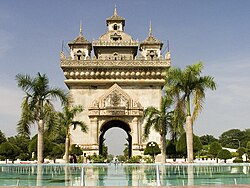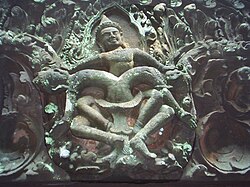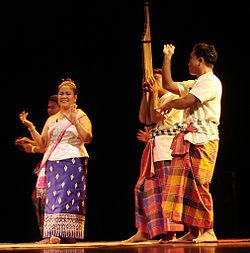Portal:Laos/Selected article
| This Wikipedia page has been superseded by Portal:Laos and is retained primarily for historical reference. |
| Note: Article entries are now being transcluded directly on the main portal page. However, this page should be retained for historical reference. |
Selected article 1
Portal:Laos/Selected article/1

Louangphabang (Lao: ຫລວງພະບາງ) or Luang Phabang (pronounced [lǔaŋ pʰa.bàːŋ]), commonly transliterated into Western languages from pre 1975 Lao spelling ຫຼວງພຣະບາງ (ຣ = silent r) as Luang Prabang, in north central Laos, consisting of 58 adjacent villages, of which 33 comprise the UNESCO Town Of Luang Prabang World Heritage Site. It was listed in 1995 for unique and "remarkably" well preserved architectural, religious and cultural heritage, a blend of the rural and urban developments over several centuries, including the French colonial influences during the 19th and 20th centuries.
The centre of the city consists of four main roads and is located on a peninsula at the confluence of the Nam Khan and Mekong River. Luang Prabang is well known for its numerous Buddhist temples and monasteries. Every morning, hundreds of monks from the various monasteries walk through the streets collecting alms. One of the city's major landmarks is Mount Phou Si; a large steep hill which despite the constrained scale of the city, is 150 metres (490 ft) high; a steep staircase leads to Wat Chom Si shrine and an overlook of the city and the rivers.
The city was formerly the capital of a kingdom of the same name. It had also been known by the ancient name of Chiang Thong. It was the royal capital and seat of government of the Kingdom of Laos until 1975. The city is part of Luang Prabang District of Luang Prabang Province and is the capital and administrative centre of the province. It lies approximately 300 km (190 mi) north of the capital Vientiane.
Selected article 2
Portal:Laos/Selected article/2

The Lao alphabet (Lao: ອັກສອນລາວ [ʔáksɔ̌ːn láːw]) is the primary script used to write the Lao language and other minority languages in Laos. It was also used to write the Isan language, but was replaced by the Thai script. It has 27 consonants (ພະຍັນຊະນະ [pʰāɲánsānā]), 7 consonantal ligatures (ພະຍັນຊະນະປະສົມ [pʰāɲánsānā pá sǒm]), 33 vowels (ສະຫລະ [sálā]), and 4 tone marks (ວັນນະຍຸດ [ván nā ɲūt]).
The Lao alphabet was adapted from the Khmer script, which itself was derived from the Pallava script, a variant of the Grantha alphabet descended from the Brahmi script, which was used in southern India and South East Asia during the 5th and 6th centuries AD. Akson Lao is a sister system to the Thai script, with which it shares many similarities and roots. However, Lao has fewer characters and is formed in a more curvilinear fashion than Thai.
Lao is written from left to right. Vowels can be written above, below, in front of, or behind consonants, with some vowel combinations written before, over and after. Spaces for separating words and punctuation were traditionally not used, but a space is used and functions in place of a comma or period. The letters have no majuscule or minuscule (upper- and lowercase) differentiation.
Selected article 3
Portal:Laos/Selected article/3

The Lao Kingdom of Lan Xang Hom Khao (Lao: ລ້ານຊ້າງຮົ່ມຂາວ; /laːn˥˧ saːŋ˥˧ hom˧ khaːw˥/; "Million Elephants and White Parasols") existed as a unified kingdom from 1354 to 1707.
For three and a half centuries, Lan Xang was one of the largest kingdoms in Southeast Asia. The meaning of the kingdom's name alludes to the power of the kingship and formidable war machine of the early kingdom. The kingdom is the precursor for the country of Laos and the basis for the national historic and cultural identity.
Under the reign of King Sourigna Vongsa (1637–1694) Lan Xang experienced a fifty seven-year period of peace and restoration. During the period the Lan Xang sangha was at the apex of power, drawing monks and nuns for religious study from throughout Southeast Asia. Literature, art, music, court dance experienced a revival. King Sourigna Vongsa revised many of the laws of Lan Xang and established judicial courts. He also concluded a series of treaties which established both trade agreements and boundaries between the surrounding kingdoms.
Lan Xang had ethnic diversity from trade and overland ethnic migrations. The multiple hill tribe peoples were grouped into the broad cultural categories of Lao Theung (which included most indigenous groups and the Mon-Khmer) and Lao Sung. The Lao Loum were ethnically dominant and there were several closely related Tai groups which included the Tai Dam, Tai Daeng, Tai Lu, Tai Yuan, and Phuan people.
Theravada Buddhism was the state religion of Lan Xang beginning with King Photisarath in 1527, but had been a growing part of cultural legacy since Fa Ngum. Within the villages, monasteries and towns of Lan Xang much of daily life revolved around the local temple or wat. The temples were centers of learning, and all males were expected to spend at least some part of their life in religious contemplation as a monk or novice. Kings could establish their legitimacy through supporting the sangha and caring for or constructing new temples.
Lan Xang was at the center of the overland trade routes in Southeast Asia. In the north and northwest the overland trade routes from Burma and Lanna passed through Lan Xang and Sipsong Panna toward Yunnan, where they would join with the Chinese Tea-Horse Road. Trade in Luang Prabang would flow down the Mekong to Vientiane where it could then be transported overland to the headwaters of the Nan and Chao Praya rivers, or overland by ox cart or elephant over the Khorat Plateau to Roi Et.
Selected article 4
Portal:Laos/Selected article/4

Patuxai (Lao: ປະຕູໄຊ, literally meaning Victory Gate or Gate of Triumph, formerly the Anousavary or Anosavari Monument, known by the French as Monument Aux Morts) is a war monument in the centre of Vientiane, Laos, which was built between 1957 and 1968. The Patuxai is dedicated to those who fought in the struggle for independence from France. In romanising the name from the Laotian language, it is variously transliterated as Patuxai, Patuxay, Patousai and Patusai. It is also called Patuxai Arch or the Arc de Triomphe of Vientiane as it resembles the Arc de Triomphe in Paris. However, it is typically Laotian in design, decorated with mythological creatures such as the kinnari (half-female, half-bird).
The Patuxai is at the end of Lang Xang Avenue in the heart of Vientiane. Patuxay Park surrounds the monument.
The monument has five towers that represent the five principles of coexistence among nations of the world. They are also representative of the five Buddhist principles of “thoughtful amiability, flexibility, honesty, honor and prosperity”.
Selected article 5
Portal:Laos/Selected article/5

Vat Phou (or Wat Phu; Lao: ວັດພູ [wāt pʰúː] temple-mountain) is a ruined Khmer Hindu temple complex in southern Laos. It is located at the base of mount Phu kao, some 6 kilometres (3.7 mi) from the Mekong in Champasak Province. There was a temple on the site as early as the 5th century, but the surviving structures date from the 11th to 13th centuries. The temple has a unique structure, in which the elements lead to a shrine where a lingam dedicated to Lord Shiva was bathed in water from a mountain spring. The site later became a centre of Theravada Buddhist worship, which it remains today.
After the first scientific description on the late 19th and early 20th century there has been little scientific activity at the site until the early 90s. With the Lao-UNESCO projects starting in 1987 and the designation as UNESCO World Heritage Site in 2001 archeological and conservational activities increased heavily.
Selected article 6
Portal:Laos/Selected article/6

The Mekong River Commission (MRC) is an intergovernmental body concerned with the Mekong River basin and charged “to promote and co-ordinate sustainable management and development of water and related resources for the countries’ mutual benefit and the people’s well-being by implementing strategic programmes and activities and providing scientific information and policy advice.”
The origins of the Mekong Committee are linked to the legacy of (de)colonialism in Indochina and subsequent geopolitical developments. The political, social, and economic conditions of the Mekong River basin countries have evolved dramatically since the 1950s, when the Mekong represented the "only large river left in the world, besides the Amazon, which remained virtually unexploited." Based largely on the recommendations of ECAFE, the "Committee for Coordination on the Lower Mekong Basin" (known as the Mekong Committee) was established in September 1957 with the adoption of the Statute for the Committee for Coordination of Investigations into the Lower Mekong Basin. ECAFE’s Bureau of Flood Control had prioritized the Mekong—of the 18 international waterways within its jurisdiction—in the hopes of creating a precedent for cooperation elsewhere. and "one of the UN's earliest spin-offs", as the organization functioned under the aegis of the UN, with its Executive Agent (EA) chosen from the carrier staff of the United Nations Development Programme (UNDP).
2001 also saw a major shift in the MRC—at least on paper—when it committed to a role as a "learning organization" with an emphasis on "the livelihoods of the people in the Mekong region." In the same year its Annual Report emphasized the importance of "bottom-up" solutions and the "voice of the people directly affected." Similarly, the 2001 MRC Hydropower Development Strategy explicitly disavowed the "promotion of specific projects" in favor of "basin-wide issues." In part, these shifts mark a retreat from past project failures and recognition that the MRC faces multiple, and often more lucrative, competitors in the project arena.
Selected article 7
Portal:Laos/Selected article/7

The Plain of Jars (Lao: ທົ່ງໄຫຫິນ [tʰōŋ hǎj hǐn]) is a megalithic archaeological landscape in Laos. It consists of thousands of stone jars scattered around the upland valleys and the lower foothills of the central plain of the Xiangkhoang Plateau. The jars are mostly arranged in clusters ranging in number from one to several hundred.
The Xieng Khouang Plateau is located at the northern end of the Annamese Cordillera, the principal mountain range of Indochina. French researcher Madeleine Colani concluded in 1930 that the jars were associated with prehistoric burial practices. Excavation by Lao and Japanese archaeologists in the intervening years has supported this interpretation with the discovery of human remains, burial goods and ceramics around the jars. The Plain of Jars is dated to the Iron Age (500 BCE to CE 500) and is one of the most important prehistoric sites in Southeast Asia.
Selected article 8
Portal:Laos/Selected article/8

Pha That Luang (Lao: ທາດຫຼວງ, IPA: [tʰâːt lwǎːŋ] 'Great Stupa') is a gold-covered large Buddhist stupa in the centre of the city of Vientiane, Laos. Since its initial establishment, suggested to be in the 3rd century, the stupa has undergone several reconstructions as recently as the 1930s due to foreign invasions of the area.
The architecture of the building includes many references to Lao culture and identity, and so has become a symbol of Lao nationalism. The stupa consists of three levels, each conveying a reflection of part of the Buddhist doctrine. The first level is 223 feet (67 metres) by 226 feet (68 metres), the second is 157 feet (47 metres) along each side and the third level is 98 feet (29 metres) along each side.
Selected article 9
Portal:Laos/Selected article/9

Lao cuisine is distinct from other Southeast Asian cuisines.
The staple food of the Lao is steamed sticky rice, which is eaten by hand. In fact, the Lao eat more sticky rice than any other people in the world. Sticky rice is considered the essence of what it means to be Lao. Often the Lao will refer to themselves as "luk khao niaow", which can be translated as "children or descendants of sticky rice". Galangal, lemongrass, and padaek (fermented fish sauce) are important ingredients.
The most famous Lao dish is larb (Lao: ລາບ; sometimes also spelled laap), a spicy mixture of marinated meat or fish that is sometimes raw (prepared like ceviche) with a variable combination of herbs, greens, and spices. Another Lao invention is a spicy green papaya salad dish known as tam mak hoong (Lao: ຕໍາໝາກຫຸ່ງ), more famously known to the West as som tam.
Lao cuisine has many regional variations, corresponding in part to the fresh foods local to each region. A French legacy is still evident in the capital city, Vientiane, where baguettes are sold on the street and French restaurants are common and popular, which were first introduced when Laos was a part of French Indochina.
Selected article 10
Portal:Laos/Selected article/10

The dance and theatre of Laos (nattakam Lao, Lao: ນາດຕະກັມລາວ [nâːt táʔ kam láːw]) is the primary dramatic art form of Laos' majority ethnic group, the Lao people. It is shared with the ethnic Lao that inhabit the Isan region of Thailand as well. There are mainly two types of dances (or dance-dramas), the classical dances performed in the royal courts and the folk dances now associated with morlam.
Shadow puppetry, although not associated with dance, is an important part of Lao theatrical traditions. Various dance-drama troupes, mostly operating out of Louang Phrabang and Vientiane, continue to teach the old classical court dances and more Khmer-influenced dramas and folk dances, respectively.
The dance-dramas of Laos were originally only performed for the royal court. The dance-dramas and musical accompaniment are all very similar to those of Thai and Cambodian classical dances. Lao legends of the first ruler of Lan Xang say that in addition to a large army of Khmer soldiers, he was also accompanied by many female dancers from the court of Angkor.
Khon (ໂຂນ [kʰǒːn]) and Cambodian Royal ballet dance is the most stylised of the Lao dance-dramas, with troupes of male and female dancers in elaborate costumes and masks performing very graceful movements demonstrating their great flexibility, and very common dance-drama form for the Phra Lak Phra Ram.
Although lacking in dance, nang taloung or shadow puppets (ໜັງຕະລຸງ [nǎŋ táʔ lúŋ]) are an important part of Lao theatrical traditions. An adaptation of the traditional Malay wayang shadow puppets, but there are numerous puppeteers instead of one puppet master. Shadow puppet plays are based on similar themes and stories as the other classical dramas, but can be accompanied by either classical music or morlam instrumentation.
